The Ultimate Audio Entertainment System
Added 12/28/2010If you travel with kids, ESPECIALLY Teenagers, you're gonna love this write-up! This one was a very cool upgrade to our entertainment capabilities in the rear seats of the RV-10. While I can't say it was dirt cheap, it wasn't really too expensive, either, considering what you get out of it in the end. It will be worth the cost, time, and effort though, if you have teens, I assure you.
First, for those that follow my write-ups, you probably already saw the write up on my PMA8000BT audio panel that I completed back in September. That audio panel has been FANTASTIC for me. Bluetooth is really a great way to go for streaming music. In the past, if we or the kids listened to music, it was through a 3.5mm jack. Unfortunately, when we plugged into the jack, if we also plugged in a charging cable, we got a whine from a ground loop. It was very annoying. Sure, you can fix it by never charging your iphone or ipad or music device, but then when you arrive at your destination a few hours later, nothing works for you anymore, and I need my phone. There are interfaces from Crutchfield (more below on that), that can help, if you use them, but using Bluetooth makes it way nicer. One less cord, one less thing to plug in. It sounds great and it's just a sweet way to go. What's the problem then? Well, we have 2 music inputs....a FRONT and a BACK (#1 and #2). Bluetooth can feed front, or all, but there is only ONE bluetooth interface on the PMA8000BT, so if Andrea and I are listening to our music (the good stuff), then the kids can't use Bluetooth. And, if the kids listen to their music, we can either listen to NONE, or theirs, if we want to use bluetooth. To make it worse, if ONE of them wants to listen to music, and one doesn't, they both have to listen to it...and if we want our silence, it can't be bluetooth. So there is more that I desired out of my system than what can be delivered stock.
By the way, for the Music #1 and #2 inputs, I have them both switched via DPDT switches, in such a way that the rear jack (Between the seats on the tunnel), and the front jack (under the throttle quadrant), can feed EITHER the #1 or #2 input source, in any combination. So, if the front seater's plug into the rear jack, and the rear seater's plug into the front jack, we can just select the appropriate switch position to hear our own music...and if I switch both switches to front, everyone hears whatever is in the front jack....and both to rear gives everyone the rear jack input. So there was quite a bit of flexibility in the system from wired perspecive, to start with. I highly recommend doing your initial Audio wiring the same way....it gives you great options.
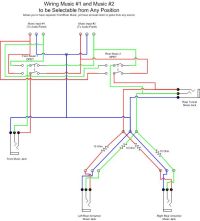
Regarding Bluetooth: If you dig in and learn about Bluetooth, you'll find out that to do streaming music, you need to do A2DP profile. Bluetooth has many profiles, one is handsfree headset, but that is only for cellphone interfacing. A2DP gives you streaming music, and even music play/pause and other controls. Here's where it gets technically challenging....how do you get A2DP to work with your headset, in the rear seat, if the people up front are using the Bluetooth audio for themselves? That's where I had to dig in a bit and come up with some good ideas.
The PMA9000EX audio panel, for you experimental nuts, is NOT A2DP profile capable, so at least at the time of this writing, the PMA8000BT is the ONLY audio panel that has bluetooth built directly into it. I wanted to clarify that for people right away, so if you're choosing your audio panel and it's important to you, make sure you understand that.
Pilot BluLink: How about using the Pilot BluLink to stream music to your headset? Hey, this product actually looks pretty good. It allows you stream music to your individual personal headset, and even use a cellphone if you want. They're available in LEMO plug (works with my bose panel-powered headsets), or standard dual-plug. What's not to like? Well, a couple things... First, they're $299 each for the LEMO plug version. That's not horrible, but it makes you blink. Second, until maybe now, all of the original models are NOT panel powered. That means you NEED BATTERIES to use them. I DO NOT want to need batteries all the time. Yeah, battery claims are high on headsets, but using Bluetooth (not cellphone), cuts the life considerably. Add to that the fact that batteries cost money, continually, and will always fail when you don't want them to. In the BluLink, I may get one trip, or 1/2 a long trip, out of a set of batteries. Supposedly, they are now releasing a 2nd updated version that will be panel-powered...that will fix this problem. But, there's still one more problem. I DON'T WANT a 2nd big, ugly control box, in-line with my headset cord...either in the front seats, or especially the rear, where the kids will bang it around, sit on it, abuse it, and the thing will just generally be in the way. If BlueLink produced a panel powered, arm-wrest mount product, I would have bought it.....something that mounds to the sidewall of the armwrest. I just plain would have done it, to save time and thinking.
Headsets: Ok, so, these days there is Bluetooth in headsets, right? So why not just get a Bluetooth capable headset? Well, here's why...
First of all, I've always loved my Bose Aviation X headsets. They are awesome, and very adjustable, even being very good at fitting very young (think 2-3 years) kids, with no big problem, yet work well for older, larger heads as well. That said, Bose really screwed up! I have no idea who made the bonehead move at Bose, but when they came out with the Bose A20 Headset this year, they DID offer bluetooth, but only the handsfree headset profile....NOT A2DP. So here you are paying basically the absolute top-dollar, for a completely awesome headset, except it lacks the ONE big feature to be fully competitive! Idiocy! Had Bose had A2DP, I would have bought them in a heartbeat. Moving on to the Lightspeed line, they have the Zulu and Sierra headsets. Well, the Sierra is just as handicapped as the new A20's are...cellphone interface only, and no A2DP to it's Bluetooth. Besides that, while the kids tried and found the Sierra headset comfortable, they have a stinkin' wide and hard headband top, and it makes them uglier, bulkier, and more likely to hit the windows and scratch the plexi if they put their heads on the windows. Ok, so how about the Zulu's? Well, this was one of my nightmare's of the year. First, the Zulu's were out of the question initially. I tried them for fit myself and I found them VERY comfortable. For the kids, however, they were way too big and unable to adjust small enough. I heard a rumor that they have a thicker headpad available for kids/small heads, so I called Lightspeed. Sure enough, they do, and they sent one to me for free....very nice, from the service end. The Zulu also DOES offer A2DP....so it's basically the ONLY choice right now if you want to stream music over Bluetooth. Kudos to Lightspeed for this! So what's NOT to like about the Zulu? Well, first of all, it's made in China. Bose is made in the USA. That's actually getting to be a bigger deal to me these days. Then, the thicker headpad is a kludge. Sure, it works, but kids don't need a bulky headset, and this just allows a headset that they designed to be too big, to finally fit smaller heads. I don't want the kids to have to wear a bigger, bulkier headset. But where it really fell apart is when we actually bought a Zulu and took it for a flight! I have to say that, after flying with the Zulu, I'm convinced that the only way that headset got good reviews for ANR quality is because Lightspeed PAYS to advertize in the places that did the reviewing....it's either that, or the ANR noice-cancelling profile just doesn't happen to work very well with the 6-cylinder IO-540 engine. Whatever the case, from the MINUTE I fired up the engine, and through testing in all phases of run-up, takeoff, climb, and cruise flight, I have to say that the Zulu's ANR capabilities just plain SUCK compared to the Bose X's. The low freqency noise of the engine was NOT cancelled nearly as well...not even really what I'd call adequately, to listen to music. The Bluetooth A2DP though, worked great...it was awesome to stream music to the headset directly. The problem was that the ANR qualities just plain stink. The headset was very comfortable for me, but very much louder than what I've been using. I also had previously used cheap Flightcom headsets, with the Headsets Inc. upgrade modules in them, and I'd have to say that I think that combo definitely outperforms the Zulu's. In order to hear music well, you'd have to turn it much louder with the Zulu's than what we did with the Aviation X's by Bose. We flew around, all 4 of us, switching back and forth between our old Bose sets, and the Zulu's, and it was a night and day difference for everyone. In fact, Andrea thought the Zulu's were bad enough that she actually thought maybe I had forgotten to turn them on!! Yes, they were that poor in the ANR Quality. I have no idea how the reviewers came to the result they did. Now, I *could* improve it a bit by grabbing both earcups and pushing in tightly, but even with them pushed in with much more clamping force, they still had nowhere near the Active ANR qualities of the Bose. You can buy thicker earpads for the Zulu's (you have to pay for those) that would probably help a little to add clamping force, but it will still never make them compare.
After posting a couple comments about my experience with the Zulu's on a couple forums, I did actually receive some personal replies from some other people who have tried them and found the same thing, even in 4-cylinder planes. They did not feel they did noise reduction as well. I'm not tied to either company...I just want the best headset I can get for my family members, but the Zulu's were a real letdown. Yes, there are big fans out there, but let me tell you what I see as a trend among fans and fanatics....often times, if someone says something like "I just love my Zulu's", you have to be careful. What they may really be saying is "I really like my Zulu's, especially because they saved me $150 over what the bose cost, and to be honest, I've never actually flight-tested the Bose and I don't know the difference". People LOVE their stuff...but often haven't actually done a head-to-head test, or they love it that they saved some money. Your personal goals may just be to have the best in comfort and performance....that's what mine are....and my review is not paid for, and is a direct head-to-head test. ** Note, the results I had with the Zulu's may not be the same result you'd have in some other type of aircraft.
Bose A20's: Again, Bose really screwed up by not offering A2DP on their A20 headset. That said, I did purchase 2 pair of them (non-bluetooth since BT won't do anything for me in my situation....already having 3 Bluetooth inputs). The Bose A20's actually DO live up to their claim. I found the Aviation X's VERY superior to the Zulu's, but found the A20's fit a little nicer, were a little lighter, and actually have a noticibly quieter ANR system than the X's do. I was shocked that they performed noticibly better, in fact. The X's were already so good that anyone would be happy. The A20's just take it a little further. The Zulu's do have the lightest clamping force, and are very comfortable....too bad on the ANR, or they'd be good competition.
So what is the goal?
Well, here was my ultimate goal list:
- Use the most comfortable headsets, with the best ANR
- Stream front seat music via Bluetooth (covered, by the PMA8000BT)
- Stream each rear seat music vi Bluetooth - INDIVIDUALLY!
- Also offer a
standard 3.5mm jack input for music, for non-Bluetooth devices
- Provide the proper impedance matching and amplification to get good audio
- Offer the option to SHARE music for the rear seats (one person's music to both headsets)
- All audio and music options must be STEREO compatible...my entire system is stereo audio
- Must be BATTERY FREE!
- *option: Offer the option to Auto-Mute the music when we yell at them from up front
So what was the solution?
Here's where it got interesting, to the geek in me! At first, I really wanted a D-I-Y project. Not only to save money, but because I thought I should be able to do it with minimal components. As it turned out, there were ways, but once you start buying components, it all adds up, and I wasn't totally sure that in the end, I'd have something with the proper audio volume gain. In the past, I've found that some audio sources, like iPod's, don't give quite the volume I'd like, especially while listening to movies. I started with trying to come up with a simple audio mixer circuit to put inline with the headset wiring. As it turned out, it was tough....you can just pass-through the headset audio, but if you don't amplify the music audio, the impedance mismatch gives very little volume. A simple mixer can fix that, but then from the technical end, the dirt simple passive mixer won't work if you want individual music in the rear seats....because on Aircraft Audio panel wiring, each rear seat does NOT have it's own headset source....at the audio panel end, or somewhere along the line, they're just tied together. So you need to use active mixing if you don't want to backfeed music into the entire rear channel headset audio.
Enter the VX Aviation ASX-2B!!! As I asked questions on the Aero-Electric list, and did lots of google searching, I both fell across the website of VX-Avation, and also got a personal reply from Vern Little...the designer of the ASX-2B and other product, as well as a fellow RV builder. The ASX-2B is designed EXACTLY for mixing Stereo Music to one headset, inline with the headset audio. It ALSO can handle a 2nd audio input and Mic input to allow for Cellphone to Headset interfacing!! Oh, and not only that, but this thing is awesome for the amplification, too! The device does a gain of 2 on the headset audio, but does a gain of 5 on the music audio input, providing all the volume you need, even if your music source is too wimpy to give you loud enough sound to hear well!! I couldn't ask for more, espeically when I heard that Vern took the time to utilize great quality components to ensure great audio clarity and quality. So, if you end up wanting to do individual rear-seat audio, I'll point you to this thing every time....it really is the ideal box, and it'll work perfect without much work.
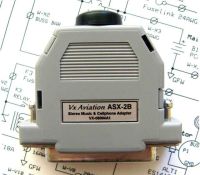
The ASX-2B is very small, built completely inside of a DB25 connector shell, and utilizes the DB25 female-pin portion of the connector. To hook it up, you just need to buy a mating DB25 plug, shell, and pins, and wire it up and plug it in. The only thing that wasn't 100% perfect was that I also had to buy the 2 little mini-nuts (female on both ends) to screw both DB25 screws into from each shell, as neither shell I bought had the female nuts built-in...but a 10-pack of nuts were only $1 tax-included at the local PC store. So this is the device that saved the day. Here is the installation manual if you're interested in what it all can do.
So what about the Bluetooth?
Well, again, here I just fell into the perfect product for what we're trying to do! I had searched for HOURS on Bluetooth to 3.5mm plug adapters...something that I could pair up with an iPad for movies, or an iPod for movies/music, and plug into a 3.5mm jack to feed into the airplane audio system. I found many devices, but then stumbled upon a Belkin product designed for home stereo's. The only downside was it was AC powered. I called Belkin and got a nice girl who I could ask if the AC adapter was un-plug-able from the device, so I could use a DC power source. She checked and said it was, but talked to the other tech support guys who said they just released a new product, designed for in-car use, that runs on 12V!! She gave me the part number and name, an 10 seconds later I was looking at it via Google! Yes, this was indeed the perfect product for this task!
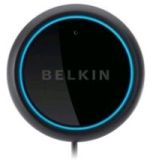
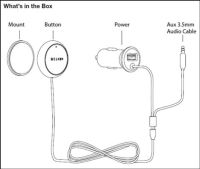
Check it out....it has a REMOVABLE (VERY IMPORTANT) magnetic base that can be sticker'd to your car's dash. You do NOT want magnets in your plane if possible...and I didn't want magnets interefering with my magnetic door latch sensors, since this device would be very close. Fortunately, the magnet is in the base, so you can take that off and throw it away...the puck itself just had a bit of metal in it. Then, there is a 3.5mm plug on the cable, and a 12V lighter plug to power it. Not only that, but the lighter plug came with a USB charging jack! This was also important. Previously, on my spring project list, I had added USB charging jacks to the rear seat armwrests. I have a 12V lighter socket under each armwrest, and had a mini-USB charger just like this, plugged into each one. This means I could simply pull out my existing charger, and plug this in place, and plug my existing USB panel mount (armwrest) cable into it and be done. VERY Simple. It works AWESOMELY! It is easy to pair with the iphone/ipod touch/iPad, and sounds great in both the car and the plane. I like it so much, I'm currently adding a 3.5mm jack to my truck, and going to buy one of these to plug into my truck stereo...to get rid of more cables. After it's paired, just fire up the iPad and it auto-connects and in no time you're listening to Bluetooth streaming music. If I have any complaint at all, it's that the cord is very flexible and not too thick. It probably isn't the most durable cord in the world, so I've protected it well and hopefully since it's hard mounted, it'll last a lifetime now. In a car, I can see it being damaged if you treated it too poorly.
Here is a picture of my install
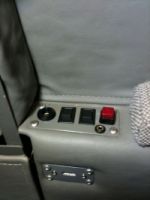 |
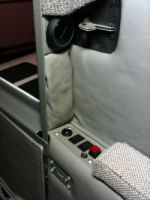 |
If you follow the write-ups, you'll notice this armwrest changed a bit since spring, when I had added the USB Charging jacks. See, I used to think I would use standard headsets some of the time. When I first built the plane, the kids didn't have Bose headsets, so I wired both Bose jacks, and regular jacks, and the other jack was a 5V power jack that they could use to charge their old movie viewing box...the Creative Zen Vision W. Well, USB charging changed the need for the 5V charging jack, and I NEVER ONCE used the standard jacks in the armwrest. I DO use the one on the tunnel though, for adding cockpit audio to my video camera. So, faced with that reality, I decided to rework these plates a bit. I added one switch (3PDT) to select between sending the music input audio for this seat, to JUST this seat, or to send it to the #2 audio input on the intercom. This allows you to connect ONE iPod, and hear it at just that one seat, or at BOTH rear seats, if you want to watch a movie together. Then I added another switch (3PDT) to select between using the 3.5mm jack hidden under the armwrest, that the Bluetooth is plugged into, or the External 3.5mm jack at the armwrest, that you can plug things like the kids' Nintendo DS's, or other non-bluetooth devices. I did NOT hook up microphone wires for cellphone inputs. I did add the red button switch from Radio Shack, to provide a way to turn off auto-mute, for more un-interrupted audio when they want it. I duplicated the same exact wiring and switching and components at the other rear seat, so now we have independent music, bluetooth or 3.5mm input, to your own headset, with the option to share it to music #2 (and thus the capability to allow ALL the people in the plane to hear it if they want to), and it meets all of the goals. In addition, you'll note that these design goals go beyond what you can do with any currently manufactured and sold device....no bluetooth headset will do all of this, no Pilot BluLink can do all of this, and no Audio panel can do all of this....and I did it for not all that much cost.
There was one other device I needed....the Crutchfield SNI-1/3.5, to provide groundloop isolation for the input sources. I've found the hard way that even this Bluetooth adapter, or any iPod that is being charged while played via the 3.5mm jack, will induce a whine in the audio system. This isolator will prevent that from happening. It was very inexpensive.

The switches and other parts I used were from DigiKey. I used (4) CKN9808-ND Switch bezel springs, (4) CKN9807-ND Switch Bezels, (4) CK204-ND switches, and (4) CF12JT10R0CT-ND 10 ohm resistors, along with those cheap radio-shack mute switches, and radio shack inline cable 3.5mm female jacks. The 3.5mm panel jacks are plastic, and thus isolated from ground, and are KM-161-7300 from http://www.kvconnection.com, although I think you can get the same thing at DigiKey from KobiConn or whatever the name is. I wish I would have been able to find switches with screw-mount bezels, as these wiggle a bit unless you put a dab of glue underneath them on the inside of the armwrest, but here is a picture of the switches I used. Everything is wired with 3 and 4 conductor wire that I had laying around.
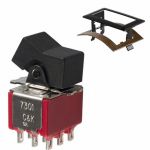
Here is the wiring diagram to the whole thing
.pdf version here
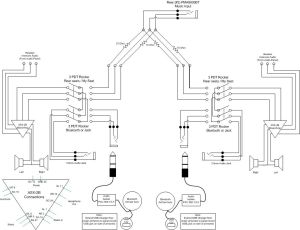
And for my own reference, here is the Bose Aviaton X guide that has the jack wiring info. Since I previously had standard jacks, with Bose jacks wired off from them, I decided to cut out the old jacks so I needed this document to refer to as I ripped out components.
So as you can see, when this is all done, there isn't much inside the plane to see. The Belkin Aircast Auto's puck is velcro'd in place at each seat. When paired, the light ring turns from orange to blue, and it just plain works. The 3.5mm jack works equally well, for other non-Bluetooth devices. I did add a simple 10 ohm resistor passive mixer network to the wiring before the Left and Right seats join with the center tunnel jack. This allows you to turn BOTH audio devices to music #2, and other than hearing a jumble of music, you don't do any damage. The diagram is pretty simple to follow. The Crutchfield device is pictured, as is the Aircast Auto, although I didn't draw the plugs on them. You'll see the switch with the 2 3.5mm jacks on it, which basically gives you the bluetooth or other option. Pretty straightforward. The ASX-2B is the heart of it all...the thing that makes it all work.
So if you have Teenagers, you don't have to force them to fight over what they listen to, and you don't have to suffer and listen to what they want to hear....you can have it all, and they don't have to put earbuds in their ears, under their headset. This audio system now has 3 separate ways to stream in bluetooth music, along with 4 3.5mm jacks where you can plug things, into 2 different music channels. In practice, anyone's music can be heard by the front seat if you want, and we can now link an iPad via Bluetooth and watch a movie and have only those who care to hear it, hear it. It does everything I can imagine needing! Oh, and if you bought a different audio panel, like the PMA9000EX, and are unhappy that you can't stream bluetooth music, it's as simple as buying the Belkin Aircast Auto, and you too can have Bluetooth streaming music in your cockpit...just wire another jack into the plane and switch to it, or plug this into your existing jack. I prefer to keep all portable wiring as hidden as possible.